Lepidoptera transposon gene tpa and application thereof
A lepidopteran transposon and lepidopteran technology, which is applied to the isolation of lepidopteran pest transposon gene fragments, and the application field of tpa gene in the detection of lepidopteran pest resistance, which can solve the problem of drug resistance and pest resistance. The genetic mechanism of medicinal properties needs to be studied, and the evaluation indicators of pesticide resistance are not clear.
- Summary
- Abstract
- Description
- Claims
- Application Information
AI Technical Summary
Problems solved by technology
Method used
Image
Examples
Embodiment 1
[0022] Take 30 3rd-instar tea geometrid larvae with moderate resistance and strong resistance to kungfuthrin, and another 30 3rd-instar tea geometrid larvae without drug resistance, and raise them in three 2L beakers respectively, and feed them with tea leaves normally. After the new shoots (5-8 / cup), the commercially available concentration of 2.5% kaufthrin emulsion is diluted 5000 times with water and then sprayed. 20 minutes after spraying, select 2-3 larvae from different drug-resistant larvae. The above larval samples were ground in different mortars with liquid nitrogen, total RNA was extracted with TRIZOL (Invitrogen) reagent, and mRNA was isolated with UNIQ-10 column mRNA extraction and purification kit (Shanghai Sangon Bioengineering Co., Ltd.). 1 μg of mRNA was used for cDNA synthesis, and double-stranded cDNA was synthesized using TakaRa MMLV RTase cDNA Synthesis Kit (Takara Bioengineering [Dalian] Co., Ltd.). After the double-stranded cDNA was purified by isoprop...
Embodiment 2
[0025]40 tea geometrids and tea caterpillar 3rd instar larvae with different resistance to kungfuthrin were taken, and each pest was divided into two groups according to their resistance, namely sensitive group and resistant group. The commercially available concentration of 2.5% kaufthrin emulsion is diluted 10000 times with water and then sprayed. After 2 hours, 1-2 larvae were selected from each of the sensitive and resistant groups for tpa expression studies. RNA was extracted by TRIZOL (Invitrogen Company), and cDNA was synthesized by MMLV first-strand cDNA synthesis kit (Shanghai Sangon Bioengineering Co., Ltd.). Using 1 μL of cDNA as a template, PCR was performed using primer SEQ ID No: 10 (since the target sequence is an inverted repeat sequence, only one primer is needed, and the product length is 434 bp). After PCR, constant voltage electrophoresis was performed on 1.5% agarose gel, and photographs were taken after electrophoresis, as shown in Figure 2. It can be s...
PUM
 Login to View More
Login to View More Abstract
Description
Claims
Application Information
 Login to View More
Login to View More - R&D
- Intellectual Property
- Life Sciences
- Materials
- Tech Scout
- Unparalleled Data Quality
- Higher Quality Content
- 60% Fewer Hallucinations
Browse by: Latest US Patents, China's latest patents, Technical Efficacy Thesaurus, Application Domain, Technology Topic, Popular Technical Reports.
© 2025 PatSnap. All rights reserved.Legal|Privacy policy|Modern Slavery Act Transparency Statement|Sitemap|About US| Contact US: help@patsnap.com

